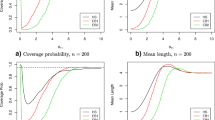Abstract
The relative belief ratio becomes a widespread tool in many hypothesis testing problems. It measures the statistical evidence that a given statement is true based on a combination of data, model and prior. Additionally, a measure of the strength is used to calibrate its value. In this paper, robustness of the relative belief ratio and its strength to the choice of the prior is studied. Specifically, the Gâteaux derivative is used to measure their sensitivity when the geometric contaminated prior is used. Examples are presented to illustrate the results.
Similar content being viewed by others
References
Abdelrazeq, I., Al-Labadi, L., & Alzaatreh, A. (2020). On one-sample bayesian tests for the mean. Accepted Statistics. https://doi.org/10.1080/02331888.2020.1726918
Al-Labadi, L. (2020). The two-sample problem via relative belief ratio. Computational Statistics. https://doi.org/10.1007/s00180-020-00988-y
Al-Labadi, L., & Berry, S. (2020). Bayesian estimation of extropy and goodness of fit tests. Journal of Applied Statistics. https://doi.org/10.1080/02664763.2020.1812545
Al-Labadi, L., & Evans, M. (2017). Optimal robustness results for relative belief inferences and the relationship to prior-data conflict. Bayesian Analysis, 12, 705–728.
Al-Labadi, L., & Evans, M. (2018). Prior based model checking. Canadian Journal of Statistics, 46, 380–398.
Al-Labadi, L., Fazeli Asl, F., & Saberi, Z. (2020). A bayesian semiparametric gaussian copula approach to a multivariate normality test. Journal of Statistical Computation and Simulation. https://doi.org/10.1080/00949655.2020.1820504
Al-Labadi, L., Fazeli Asl, F., & Saberi, Z. (2021). A test for independence via bayesian nonparametric estimation of mutual information. Canadian Journal of Statistics. https://arxiv.org/abs/2002.03490
Al-Labadi, L., Fazeli Asl, F., & Wang, C. (2021). Measuring bayesian robustness using rényi divergence. Stats, 4, 251–268. https://doi.org/10.3390/stats4020018.
Al-Labadi, L., Patel, V., Vakiloroayaei, K., & Wan, C. (2020). Kullback–Leibler divergence for bayesian nonparametric model checking. Journal of the Korean Statistical Society. https://arxiv.org/abs/1903.00669
Al-Labadi, L., Zeynep, B., & Evans, M. (2017). Goodness of fit for the logistic regression model using relative belief. Journal of Statistical Distributions and Applications. https://doi.org/10.1186/s40488-017-0070-7.
Al-Labadi, L., Zeynep, B., & Evans, M. (2018). Statistical reasoning: Choosing and checking the ingredients, inferences based on a measure of statistical evidence with some applications. Entropy, 20, 289. https://doi.org/10.3390/e20040289.
Baskurt, Z., & Evans, M. (2013). Hypothesis assessment and inequalities for Bayes factors and relative belief ratios. Bayesian Analysis, 8, 569–590.
Berger, J. (1984). The robust Bayesian viewpoint (with discussion). In J. Kadane (Ed.), Robustness in Baysian Statistics. Amsterdam: North-Holland.
Berger, J. (1990). Robust Bayesian analysis: Sensitivity to the prior. Journal of Statistical Planning and Inference, 25, 303–328.
Berger, J., & Berliner, L. M. (1986). Robust Bayes and empirical Bayes analysis with c-contaminated priors. Annals of Statistics, 14, 461–486.
Das Gupta, A., & Studden, W. J. (1988). Robust Bayesian analysis and optimal experimental designs in normal linear models with many parameters I, Tech. Report, Department of Statistics, Purdue University.
Das Gupta, A., & Studden, W. J. (1988). Variations in posterior measures for priors in a band: Effect of additional restrictions, Tech. Report, Department of Statistics, Purdue University.
De Robertis, L., & Hartigan, J. A. (1981). Bayesian inference using intervals of measures. Annals of Statistics, 9, 235–244.
Dey, D. K., & Birmiwal, L. R. (1994). Robust Bayesian analysis using divergence measures. Statistics & Probability Letters, 20, 287–294.
Diaconis, P., & Freedman, D. (1986). On the consistency of Bayes estimates. Annals of Statistics, 14, 1–67.
Evans, M. (2015). Measuring statistical evidence using relative belief. Monographs on Statistics and Applied Probability 144, CRC Press, Taylor & Francis Group.
Evan, M., & Tomal, J. (2018). Measuring statistical evidence and multiple testing. FACET, 3, 563–583.
Gelfand, A. E., & Dey, D. K. (1991). On measuring Bayesian robustness of contaminated classes of priors. Statistics and Decisions, 9, 63–80.
Gustafson, P., & Wasserman, L. (1995). Local sensitivity diagnostics for Bayesian inference. Annals of Statistics, 23, 2153–2167.
Kass, R. E., & Raftery, A. E. (1995). Bayes factors. Journal of the American Statistical Association, 90, 773–795.
Ruggeri, E., & Wasserman, L. (1993). Infinitesimal sensitivity of posterior distributions. Canadian Journal of Statistics, 21, 195–203.
Sivaganesan, S., & Berger, J. (1989). Ranges of posterior measures for priors with unimodal contaminations. Annals of Statistics, 17, 868–889.
Wasserman, L. (1989). A robust Bayesian interpretation of likelihood regions. Annals of Statistics, 17, 1387–1393.
Acknowledgements
The authors thank the Editor, the Associate Editor and anonymous referees for their important and constructive comments that led to significant improvement of the paper. In particular, the connection with covariance in Proposition 2 is highly appreciated.
Author information
Authors and Affiliations
Corresponding author
Additional information
Publisher's Note
Springer Nature remains neutral with regard to jurisdictional claims in published maps and institutional affiliations.
Appendices
Appendix A Proof of Proposition 1
From (8),
Using L’Hôpital’s rule, we get
From (6),
Let \(h(\epsilon )=c(\epsilon )\pi ^{1-\epsilon }(\theta )q^{\epsilon }(\theta )\). Then
It follows that
Thus,
As \(\epsilon \rightarrow 0,\) we have
Thus,
Appendix B Proof of Proposition 2
Let \(\Pi _{\epsilon }(\cdot |x)\) be the posterior cumulative distribution function with posterior density \(\pi _{\epsilon }(\cdot |x)\). By (7) and (8),
Observe that,
Therefore,
Using L’Hôpital’s rule,
where \(h(\epsilon )=c(\epsilon )\pi ^{(1-\epsilon )}(\theta )q^{\epsilon }(\theta )\). Hence,
Applying \(\frac{d}{d\epsilon }h(\epsilon )\) given by (10) in the above equation gives
After some simplification, we obtain
Letting \(\epsilon \rightarrow 0\) makes
On the other hand, since \(h(\epsilon )\rightarrow \pi (\theta )\) and \(\frac{d}{d\epsilon }m_{\epsilon }(x)\rightarrow m(x) E_{\pi (\theta |x)}\left[ \log \left( \frac{q(\theta )}{\pi (\theta )}\right) \right]\) as \(\epsilon \rightarrow 0\), we have
Thus, as \(\epsilon \rightarrow 0\),
Rights and permissions
About this article
Cite this article
Al-Labadi, L., Asl, F.F. On robustness of the relative belief ratio and the strength of its evidence with respect to the geometric contamination prior. J. Korean Stat. Soc. 51, 961–975 (2022). https://doi.org/10.1007/s42952-022-00170-8
Received:
Accepted:
Published:
Issue Date:
DOI: https://doi.org/10.1007/s42952-022-00170-8



